Improving Tangential Flow Filtration Yield
Best methods to maximize product yield and membrane lifetime to enhance a tangential flow filtration process.
ABSTRACT
Selection and sizing of membrane flat-sheet cassette devices are critical to a successful tangential flow filtration (TFF) process. To maximize return on investment, the devices should boost product yields while offering cleaning and reuse results that provide superior membrane lifetime cost benefits. In this case, small-scale models were developed and executed to test and evaluate selected membrane devices for a protein concentration–diafiltration application, in which the current device delivered unacceptable product recovery and cleaning and reuse results. The application involved the last purification step of a recombinant bacterial protein. Characterization and optimization of operating process parameters were followed by performance verification at the pilot plant, and by full commercial-scale use of the device selected.
Optimization of tangential flow filtration (TFF) processes and membrane lifetime studies have been previously reported in detail.1–3 However, the application to a final purification step involving a bacterial protein for product yield and membrane lifetime enhancements requires an evaluation based on the nature of the feedstock and the purpose of the purification step. Wang, et al., proposed a 10-cycle lifetime for membranes used in a primary recovery TFF process.2 However, that TFF process was designed to handle human monoclonal antibody (HuMab) cell culture harvest material at the start of purification. In a separate review, Rathore, et al., affirmed the importance of reusing membrane filters for multiple cycles before replacing them, and these researchers provided a basis for conducting validation activities for up to 100 cycles of high-volume monoclonal antibody product.3 To improve a TFF process economically, product yield and membrane lifetime should be maximized.
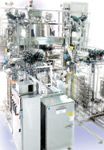
Millipore Corporation
The commercial-scale process for the application in question did not previously have a reuse strategy in place, and product recovery was not maximized. Historical data for the application showed average product yields of approximately 94% with the current polyethersulfone-based (PES-based) membrane. The PES-based membrane was also too difficult to clean to the required normalized clean water permeability (NCWP) standards to implement a satisfactory reuse strategy. In the current study, selected membrane types were tested in laboratory models and their performances were assessed based on product yields and NCWP recoveries. Laboratory studies demonstrated that regenerated cellulose membranes offer better yields and better reuse potential than PES-based membranes for this application. Optimization of the operating parameters focused on product load per surface area, crossflow rate, and transmembrane pressure (TMP). The combination of selecting a new membrane type and optimizing operating parameters led to significant increases in yield. The regenerated cellulose membranes and the new process delivered up to 100% yields in the laboratory and 99% yields at the pilot-plant scale. The low protein-binding nature of the regenerated cellulose membranes also facilitated simple caustic cleaning regimens and stable NCWP values.
In the end, laboratory-scale membrane lifetime studies of the characterized regenerated cellulose membrane processes showed sustained product yields and satisfactory performance over 30 use cycles. The development, characterization strategy, and summary of results are presented here.
LABORATORY-SCALE PROCESS DEVELOPMENT
The molecular weight cut-off (MWCO) of a membrane is crucial to the retention capability of the target molecule. The recommended choice is generally a membrane with an MWCO rating of less than 1/3 the size of the molecule to recover.4 Following this rule allows the process characterization to proceed efficiently to select the best operating parameter ranges and to optimize for large-scale trials. In the current study, the existing application used a PES-based membrane with an MWCO of 8 kDa, which is greater than 1/3 the size of the molecule to recover. The new membranes tested had MWCO ratings of 1/3 or less of the size of the molecule of interest.
To demonstrate reproducibility of the laboratory model to the commercial process, the commercial TFF process of interest was scaled down to the appropriate laboratory scale and process conditions. The product load per surface area is a critical parameter to consider when designing the proper small-scale model. Conducting experiments at various loads per surface area is important for studying membrane performance over different product-load ranges and its effects on process cycle times.
During the initial phase of laboratory-scale process development, three types of membranes were tested to screen out the two with the lowest performance potential. The following membrane devices were tested: a PES-based 8 kD device (current); a PES-based 5 kD (new); and a regenerated cellulose–based 5 kD device (new).
Flux (JF) is the permeate flow rate per unit surface area (in this case, in L/min.h or simply, LMH). To assess process optimization performance in regard to crossflow rates, TMPs, and their associated permeate flow rates, JF-versus-TMP curves were constructed for each membrane. Crossflow rates and TMP ranges were selected according to commercial process capabilities. To ensure performance assessments over the entire process range, the JF-versus-TMP curves were developed at both the initial and final protein concentration levels. Figures 1 and 2 show the JF-versus-TMP relationships for the three membranes types at the approximate initial and final concentration levels, respectively.

Figure 1
As shown in Figures 1 and 2, the PES-based 8 kDa membranes exhibited the highest permeabilities across the crossflow rates and TMP ranges studied. Both 5 kDa membranes had lower flux profiles, with the regenerated cellulose device showing the least permeability. Flux profiles are a good predictor of process cycle times. Flux profiles should be evaluated for decreasing trends, which could signal fouling or excessive polarization across the membrane surface. In this case, when comparing both PES-based devices, researchers noted lower permeabilities with the higher concentration profiles shown in Figure 2. This fact translates into a flux decrease during the concentration process, as a result of membrane polarization or fouling. Although the regenerated cellulose membranes led to slower cycles times because of their lower permeabilities, they exhibited more stable flux profiles than did the PES-based membranes. The flux profiles were essentially the same for all evaluated crossflow rates and protein concentration levels. This fact shows that the regenerated cellulose membranes are less susceptible to membrane polarization or fouling with the protein of interest. In addition, because the PES-based 8 kDa membrane pore size is the largest of the three membranes tested, its flux is the most dependent on crossflow rates; hence, the PES-based 8 kDa membrane showed a greater variability in performance.
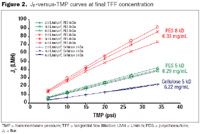
Figure 2
Higher permeabilities could also lead to product losses through the membrane. Transmissibility refers to the permeability, or transmission, of the product component through the membrane layers. Figures 3 and 4 show the transmissibility profiles according to permeate absorbance measurements taken during the JF-versus-TMP trials. The absorbance measurements are given in milli-absorbance units (mAU).
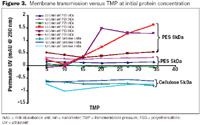
Figure 3
As the PES-based membranes exhibit binding of the protein along the membrane surface when the membrane is exposed to the protein at high TMPs, the transmissibility across the membrane increases and is noticeably higher for the PES-based 8 kDa device. The transmissibilities are even higher at the high protein concentration levels (Figure 4). Data show less transmissibility for the 5 kDa devices, particularly the regenerated cellulose 5 kDa, for which data suggest zero transmissibility. The nonpositive values were the result of the online ultraviolet (UV) meter not being zero-adjusted to provide the correct absorbance baseline for the process buffer solution; however, the trend differences are significant among the devices. The higher the transmissibility, the higher the risk of product loss across the membrane during full concentration–diafiltration processes. As the data show, PES-based 5 kDa membranes are also favorable in terms of product retention capability; however, for our application, historical data have established that PES-based devices pose cleaning and reuse challenges because of their high protein binding. This excessive polarization of PES-based membranes is discussed in detail in the following section of this article.
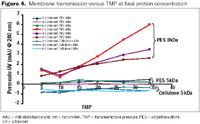
Figure 4
SMALL-SCALE MODEL DESIGN AND EXECUTION
Small-scale concentration–diafiltration runs were executed to test membrane performance in accordance with operating parameter data from the JF-versus-TMP tests. Based on the JF-versus-TMP trials, crossflow rates and TMP parameter values can be assessed to perform small-scale concentration–diafiltration runs. For the PES-based devices, crossflow rates of 3.0 LPM/m2 at a TMP of 20 psig were selected. For the regenerated cellulose runs, crossflow rates of 2.0 and 3.0 LPM/m2 were selected along with TMPs of 20 and 25 psig. Product load levels of 25, 34, and 51 g/m2 were initially tested to provide a range of the expected protein load to the system. When combining all these options into the experimental design, it is important to note the expected outcomes in terms of process cycle times and large-scale system capacity, because processing at 3.0 LPM/m2 at a TMP of 25 psig may not be possible at large scale if pressure drops are extreme in a large-scale skid. The size and capacity of the large-scale pump should also be considered.
Product recovery schemes are also of critical importance when designing and conducting small-scale model experiments. The initial transfer out of concentrated bulk material from the system was the first step, as it should be for every recovery scheme. A single flush or a series of flushes with the appropriate buffer solution followed the initial transfer out of the runs. Some of the flushes were circulated for times ranging from 5 to 15 minutes at no TMP to allow sweeping of the membrane and release of additional material. Careful attention should be given not to overshoot the final target concentration (if specified) when performing the flushes.
The cassettes used in the scale-down models had membrane areas of 50 cm2 and 0.1 m2. The large-scale commercial process is based on 20 m2 total area; therefore, scale-down factors of 4,000 and 200 were used. The amount of diluted protein material was fixed to provide target product loads of 25, 34, and 51 g/m2 for each case. The benchtop TFF processes were performed with an äKTA crossflow system equipped with Unicorn software to collect and analyze process data. The quality attributes of the final product were verified by analytical methods designed to assess purity, identity, and potential byproducts such as dimers and aggregates. Verification of these attributes is important to investigate potential detrimental effects of the membranes or of the process on the nature of the final product.
Figure 5 shows resulting trends for a concentration process with a PES-based 8 kDa membrane system. The trends show a steady decline of the process flux while exhibiting a steady rise of the permeate UV curve. The rise is particularly distinctive during the latter stages of the concentration. The process was run at a product load of 51 g/m2; however, similar trends were obtained at 34 and 25 g/m2. The mass balance showed a 2.5% loss of product through the permeate stream and a total recovery of 96%. Product recoveries for the PES-based 8 kDa systems ranged from 91.2 to 96.0%, and permeate losses ranged from 2.5 to 6.2%. Given this data, PES-based 8 kDa devices clearly are not the best option to maximize yield for this application. With flux values from 80.1 to 53.3 LMH, for the PES-based 8 kDa systems the only benefit observed was the fast processing time. However, permeate losses and decreases in flux performance were the main factors considered to reject the devices. In addition, with simple caustic regimes it was impossible to clean the soiled membranes and restore their permeability to the acceptable criteria for further reuses.
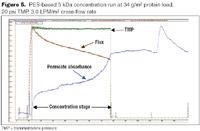
Figure 5
Figure 6 shows the resulting trends for a PES-based 5 kDa concentration at a 34 g/m2 protein load. A steady flux decrease was also noted. However, the permeate absorbance profile did not show a trend indicative of product loss. The absorbance oscillated around values well below the ones observed for the PES-based 8 kDa device, indicating better retention for the PES-based 5 kDa membrane. Recoveries for this latter device ranged from 95.3 to 100%. The average flux values ranged from 34.6 to 24.2 LMH for this system, leading to slower process cycle times in comparison to the PES-based 8 kDa device; this was obviously related to the smaller pore size.
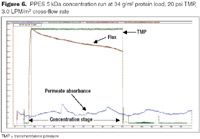
Figure 6
Figures 7 and 8 show trends for regenerated cellulose 5 kDa TFF small-scale processes. Figure 7 corresponds to a concentration run at 25 g/m2 load with a crossflow rate of 3.0 LPM/m2 and a TMP of 20 psig. Figure 8 shows a concentration–diafiltration run at a 34 g/m2 protein load. Crossflow rate and TMP were set at 2.0 LPM/m2 and 25 psig for this system. As the figures show, the flux profiles were very stable with minor flux degradation. Permeate absorbance trends were also very stable and were contained under values leading to nondetectable protein losses. The permeate flux values ranged from 13.0 LMH to 14.5 LMH for the regenerated cellulose 5 kDa systems, leading to the longest cycle times. The stable flux profiles were a result of the low binding nature of the membranes, which led to minimal fouling. This benefit, combined with the absence of permeate product losses, outweighed that of longer cycle times for commercial implementation of this application. Provided a satisfactory cleaning and reuse result, the longer cycle time was offset by the time savings of not needing to install new cassettes for every lot processed. Table 1 shows a performance comparison summary of the three membrane devices.
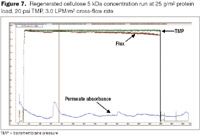
Figure 7
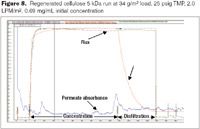
Figure 8
Based on the performance observed during bench-scale experimentation, the regenerated cellulose 5 kDa devices offer the best qualities and risk-benefit profile. Quality testing showed no detrimental effect on the purity and identity of the product. The regenerated cellulose membranes at the 5 kDa MWCO specification offered the best product recovery and cleaning and reuse potential; therefore, development and scale-up activities continued with a pilot-plant trial.

Table 1. Summary of laboratory scale developmental runs for PES 8 kDa, PES 5 kDa, and regenerated cellulose 5 kDa systems
PILOT-PLANT STUDIES
Regenerated cellulose cassettes with 2.5 m2 membrane area were used for the pilot-plant runs. The protein load target was set at 34 g/m2. To process the available material at this product load, 10 m2 of filtration area were required. To prepare the system, four membrane devices were assembled, flushed, integrity tested, sanitized, reflushed, and buffer equilibrated. The pilot system was manually constructed with flexible hoses, a recirculation pump, cassette housing, and line elements, such as flow meters, pressure transmitters, manual valves, and temperature elements. A 100-L vessel served as the retentate tank, and a 750-L portable tank contained the diluted bulk protein product.
During the membrane preparation activities, an initial NCWP measurement was taken before equilibration to provide a baseline NCWP. The baseline NCWP was measured at 0.975 LMH/psig. On completion of preparation and equilibration activities, the concentration–diafiltration process was carried out. Crossflow rate and TMP parameters were set at 2.0 LPM/m2 and 25 psig respectively, because bench-work development had demonstrated satisfactory performance at these values. Table 2 provides a summary of the performance highlights noted with the pilot-plant run.

Table 2. Pilot plant run summary for regenerated cellulose 5 kDa
Two buffer flushes equal to 1.2 system hold-up volumes were performed after the initial product transfer out, each with 15-minute circulation periods. A crossflow rate of 0.5 LPM/m2 was used during the circulations to rid the membrane of any remaining traces of product. In the end, a final recovery of 98.9% was achieved. Ultraviolet analyses on permeate samples found no detectable product losses.
Process flux was at a steady 13.8 LMH during the concentration phase, before drifting slightly to 12.6 LMH at the end of diafiltration. These values are in line with benchtop data and further support the low protein-binding qualities of the regenerated cellulose membranes toward the molecule in question. Given the minimal membrane soiling experienced at the pilot scale, post-use cleaning was performed with a simple caustic solution of 0.2 N NaOH. Room temperature conditions were used, and cleaning crossflow rates and TMPs were similar to the ones used during product processing.
The NCWP increase or decrease over time is measured in terms of NCWP recovery. NCWP recovery is defined as:

On cleaning and flushing the membranes to the required neutrality conditions, a final NCWP measurement was taken and measured at 0.99 LMH/psig. This signified a 101.5% NCWP recovery, which met the acceptable criteria for reuse, and which was much better than previous results with PES-based 8 kDa devices.
MEMBRANE REUSE STUDIES
Given the satisfactory pilot-plant and benchtop performance of the regenerated cellulose 5 kDa devices, cleaning and reuse studies at the bench-scale were conducted. The small-scale model design required at least 30 use cycles at processing conditions modeled with the commercial process conditions. Previous runs at 25 or 34 g/m2 of product load produced satisfactory outcomes; however, cycle times were longer than for the existing commercial operation. To mitigate the potential for long process cycle times during scale-up, other factors can be considered. The membrane area can be increased to further reduce the protein load and increase the permeate flow rate. In this case, the commercial operation needed to maintain process cycle times in a specific time frame, so the product load was decreased to 17 g/m2 for commercial implementation.
When designing cleaning and reuse small-scale models, it is important to conduct studies at the large-scale target load to ensure that membranes are exposed to the expected amount of product under similar processing conditions. Because of cycle time restrictions, an increase in the commercial-scale filtration area from 20 m2 to 30 m2 would provide higher permeate flow rates and total cycle times within process requirements. Along with the target product load of 17 g/m2, the concentration–diafiltration runs were performed at the same crossflow rate and TMP operating conditions as in the pilot-plant studies (2.0 LPM/m2 and 25 psig).
The preparation and cleaning phases of the membrane were designed and carried out according to the expected large-scale conditions and commercial-scale requirements. These phases included chemical storage of the membrane in the system, in which commercial system requirements could play a role. In this case, the commercial skid system was cleaned and stored in a 0.2 N NaOH solution. For the current application, the regenerated cellulose membranes were cleaned with a 0.2 N NaOH solution, but they had been stored at 0.1 N NaOH. To consolidate cleaning and storage of the membrane in the commercial skid system, storage at 0.2 N NaOH and its effects on long-term performance were investigated with the small-scale reuse studies.
The cleaning effectiveness and clearance of residual protein from the membrane was determined by execution of blank runs and by NCWP measurements. The blank runs were performed according to the product runs, with the only difference being that clean buffer was used as the process feed material. The blank runs were performed following a post-use cleaning procedure, with the goal of collecting samples for an enzyme-linked immunosorbent assay (ELISA) analysis specific to the protein of interest. The samples were verified for traces of protein and compared to acceptable criteria for post-use cleaning conditions. Four blank runs were assigned and spread throughout the 30 use cycle schedule with the intention of grouping blocks of consecutive process and cleaning cycles, thereby challenging the membrane sequential-use regimen, and thereby ensuring the uniformity and bracketing of data.
Figure 9 shows the NCWP recovery profile obtained for the 30 process runs and the additional 4 blank runs. NCWP measurements were taken before and after each run; therefore, 68 data points are shown. The chart shows a gradual rise in the NCWP trend, signaling potential membrane degradation over time as the membrane is subjected to the repeated cleaning and reuse cycles. However, the small rise is within the established specifications for the membrane. The final NCWP recovery obtained at the end of the cycles was 109.1%, which met the acceptance criteria for the application. The current acceptance criteria range is 70 to 130% of NCWP recovery. No impact on the performance of the membrane is expected because of the 109.1% increase in NCWP. This expectation is supported by the total average product yields for the process runs, which were at 100% with no protein losses detected through the permeate stream.

Figure 9
The ELISA analyses performed on the blank-run samples showed satisfactory clearance of residual protein from the system on completion of the cleaning cycles. These results demonstrated that the regenerated cellulose 5 kDa membranes can be cleaned to the required acceptance criteria with a 0.2 N NaOH solution at 25 °C and with processing conditions similar to those used in product processing. The execution of the blank runs spread throughout the 30-cycle schedule (with one at the very end), and their satisfactory results provide justification to support effective clearance and no carryover of product at a 17 g/m2 load for up to 30 run cycles. These results are representative of the projected commercial process load in conjunction with the membrane material to be used; however, these results do not take into account the potential differences introduced by commercial-scale equipment. These differences must be studied using commercial-scale equipment.
COMMERCIAL SCALE-UP
Following completion of all laboratory and pilot-scale development, the process improvement project is introduced to commercial operations. The success of the project requires a collaborative effort among process development, operations, automation, validation, regulatory affairs, quality, analytical sciences, and related support groups. Clear goals must be set, and project planning plays a crucial role in establishing and ensuring the completion of each milestone.
For the current protein application, and based on the development work previously discussed, the changes proposed to the current commercial operation are illustrated in Table 3. The first step was to evaluate, develop, and incorporate the required changes to the automation code to carry out the new operation. Close collaboration with automation was crucial to ensure the introduction of new process parameter setpoints, ranges, and alarms.

Table 3. Comparative summary of the changes involved with the introduction of the new membranes to commercial large-scale TFF processing
Water runs were performed to challenge the new automation code and TFF system performance with the new process parameters. In addition to verification of new code functionality, other tests were performed, such as tests to verify total system hold-up volumes and minimum displacement volumes along piping sections. These tests were useful for designing the appropriate recovery strategy, and for ensuring that the proposed recovery sequence did not overshoot the specified product concentration target. Other tests involving utilities and mechanical elements of the system were executed to verify air pressures, pump capacities, and other functionalities that might be affected because of proposed changes.
Once all automation work was completed and functionality was verified, large-scale engineering runs were scheduled to challenge the new process with product. An important part of the engineering runs was sampling and analytical testing. In addition to the required testing for quality and validation purposes, samples were taken throughout the various phases of the process for mass balance calculations. Protein concentration was determined and, along with process weight data, a detailed mass balance was performed.
Engineering lot preparation activities included all the activities associated with the membrane installation, flushing, cleaning, integrity testing, and equilibration. Because the filtration area was being increased from 20 m2 to 30 m2 and the devices varied, researchers evaluated the removal of the preservative in which the devices are shipped. Samples were collected during the initial water flush phase and were analyzed for preservative concentration. The flushing studies concluded that 600 L of water through both the retentate and permeate sides was enough to clear the preservative solution from the membranes to below the limit of quantification (LOQ) of the analytical method.
Pre-use cleaning and integrity testing included incorporation of the cleaning phases tested at the laboratory and the initial NCWP measurement. Caustic clearance from the system was evaluated by collecting samples during water flushing and rinses until the specified conductivity criteria and neutral pH conditions were achieved. To ensure proper installation of the devices and to verify the integrity of the membranes, air diffusion testing was performed on the cassette assembly, and the diffusion rate was compared to the accepted criteria for the devices. The NCWP measurement and equilibration phases completed the membrane preparation activities to set up the system for processing.
One of the most challenging phases when scaling up TFF processes is the product recovery phase. This phase is highly dependent on proper TFF large-scale system skid design; therefore, the system piping and geometric arrangement must be carefully studied before implementing any of the recovery methods developed at the bench or pilot scales.
A disadvantage of the current system was the location of the dispensing port. The port was located at a high point downstream from the membranes on the retentate return line. To take advantage of gravity effects and to maximize yields, researchers recommended dispensing from the lowest possible point in the system, in this case upstream from the membranes on the feed line. The dispensing port was relocated to the low point, and the recovery strategy was modified to include reverse plug flow rinses of the membrane and to take advantage of gravity effects. Special care was taken to avoid excessive foaming of the bulk protein solution during the various transfer phases of the recovery process, especially when using air-displacement methods. Excessive foaming of the bulk solution could result in aggregation of the protein.
In the end, the full-scale concentration–diafiltration process was completed according to expectations. Final yields were slightly below bench-and pilot-scale results at 97.5%; however, continued fine-tuning of the recovery phase could increase final yields. The flux profiles continued their stable trends between 12.5 and 14.0 LMH, and process cycle times were within expectations. On post-process cleaning of the membranes, a 101.9% NCWP recovery was obtained, which was very similar to data observed during small-scale studies. All analytical testing performed on the samples collected showed satisfactory results, with identity, purity, and quality attributes meeting the established acceptance criteria.
CONCLUSIONS
As summarized in Table 4, the laboratory-scale development, pilot-plant trials, and cleaning and reuse runs provided a solid baseline for a major process improvement involving the change from a PES-based 8 kDa membrane to a regenerated cellulose 5 kDa device. Large-scale engineering runs provided reassurance of all the previous development work results.

Table 4. Performance summary for the regenerated cellulose 5 kDa membrane devices, from benchtop development to large-scale engineering runs
The cleaning and reuse capacity of the new membranes was demonstrated, and this fact will allow the commercial operation to develop and implement a new reuse strategy. Once the new membranes are fully implemented, substantial financial benefits are expected, as a result of the projected 3% product yield increase and the reuse strategy.
Carlos A. Dominguez and Esteban Rivera are senior engineers, Carlos Escobar is a principal engineer, and James Weidner is a director, all at bulk process development, Amgen Manufacturing, Ltd., Juncos, PR, 787.916.6909, cdomingu@amgen.com
REFERENCES
1. Rathore AS, Wang A, Menon M, Martin J, Campbell J, Goodrich E, et al. Optimization, scale-up, and validation issues in filtration of biopharmaceuticals, part 2. BioPharm Int 2004;17(9):42–50.
2. Wang J, Diehl T, Watkins-Fischl M, Perkins D, Aguiar D, Arunakmari A. Optimizing the primary recovery step in nonaffinity purification schemes for HuMAbs. BioPharm Int. 2008;3(suppl):4–10
3. Rathore AS, Samavedam R, Morrison R, Kichefski T, Cote S. Lifetime studies for membrane reuse: principles and case studies. BioPharm Int. 2007;20(9):48–54.
4. Protein concentration and diafiltration by tangential flow filtration. Technical brief. Billerica (MA): Millipore Corporation; 2003. Millipore Technical Brief: TB032.
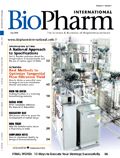
Newsletter
Stay at the forefront of biopharmaceutical innovation—subscribe to BioPharm International for expert insights on drug development, manufacturing, compliance, and more.
Mechanistic Hypothesis of Toxicity: Driving Decision Making in Preclinical Translation
July 16th 2025Mechanistic toxicity hypothesis is essential in guiding decision-making and predicting toxicities during the preclinical stages of drug development. The authors highlight the growing importance of integrating advanced technologies like mass spectrometry imaging into toxicology to enhance preclinical translation, foster innovation in therapeutic development, and ultimately improve drug safety and efficacy.